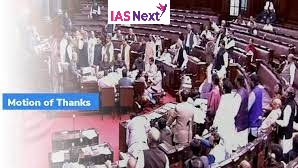CURRENT AFFAIRS
Get the most updated and recent current affair content on Padhaikaro.com
Motion of thanks to the president
- IAS NEXT, Lucknow
- 04, Feb 2022

Reference News:-
The President’s speech at the start of the Budget Session usually highlights the government’s achievements over the past year and outlines targets and plans for the future.
- This speech will be followed by the discussion on motion of thanks to the President’s address.
What is Motion of Thanks?
The address is followed by a motion of thanks moved in each House by ruling party MPs. During the session, political parties discuss the motion of thanks also suggesting amendments.
- President’s Address and Motion of Thanks are governed by Articles 86 (1) and 87 (1) of the Constitution and Rules 16 to 24 of the Rules of Procedure and Conduct of Business in Lok Sabha.
Amendments to the “Motion of Thanks”:
- Notices of amendments to Motion of Thanks on the President’s Address can be tabled after the President has delivered his Address.
- Amendments may refer to matters contained in the Address as well as to matters, in the opinion of the member, the Address has failed to mention.
- Amendments can be moved to the Motion of Thanks in such form as may be considered appropriate by the Speaker.
Limitations:
- Members cannot refer to matters which are not the direct responsibility of the Central Government.
- The name of the President cannot be brought in during the debate since the Government and not the President is responsible for the contents of the Address.
Its passage:
- Members of Parliament vote on this motion of thanks. This motion must be passed in both of the houses.
- A failure to get motion of thanks passed amounts to defeat of government and leads to collapse of government. This is why the Motion of Thanks is deemed to be a no-confidence motion.